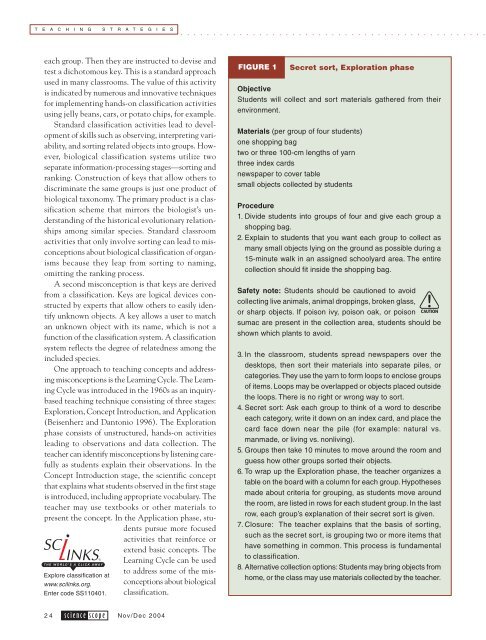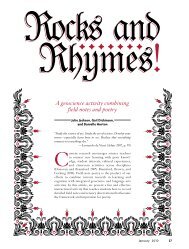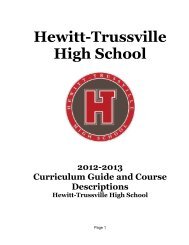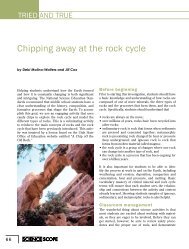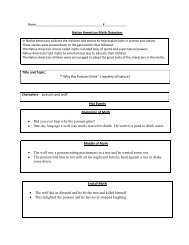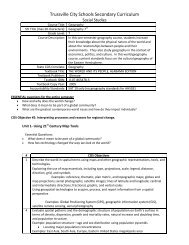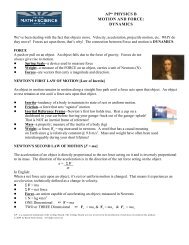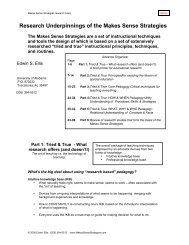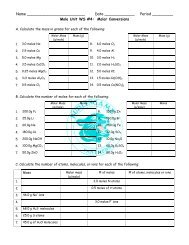WhatBelongsin Your 15-Bean Soup? - NSTA Learning Center
WhatBelongsin Your 15-Bean Soup? - NSTA Learning Center
WhatBelongsin Your 15-Bean Soup? - NSTA Learning Center
Create successful ePaper yourself
Turn your PDF publications into a flip-book with our unique Google optimized e-Paper software.
○ ○ ○ ○ ○ ○ ○ ○ ○ ○ ○ ○ ○ ○ ○ ○ ○ ○ ○ ○ ○ ○ ○ ○ ○ ○ ○ ○ ○ ○ ○ ○ ○ ○ ○ ○ ○ ○ ○ ○ ○ ○ ○ ○ ○ ○ ○<br />
T E A C H I N G S T R A T E G I E S<br />
each group. Then they are instructed to devise and<br />
test a dichotomous key. This is a standard approach<br />
used in many classrooms. The value of this activity<br />
is indicated by numerous and innovative techniques<br />
for implementing hands-on classification activities<br />
using jelly beans, cars, or potato chips, for example.<br />
Standard classification activities lead to development<br />
of skills such as observing, interpreting variability,<br />
and sorting related objects into groups. However,<br />
biological classification systems utilize two<br />
separate information-processing stages—sorting and<br />
ranking. Construction of keys that allow others to<br />
discriminate the same groups is just one product of<br />
biological taxonomy. The primary product is a classification<br />
scheme that mirrors the biologist’s understanding<br />
of the historical evolutionary relationships<br />
among similar species. Standard classroom<br />
activities that only involve sorting can lead to misconceptions<br />
about biological classification of organisms<br />
because they leap from sorting to naming,<br />
omitting the ranking process.<br />
A second misconception is that keys are derived<br />
from a classification. Keys are logical devices constructed<br />
by experts that allow others to easily identify<br />
unknown objects. A key allows a user to match<br />
an unknown object with its name, which is not a<br />
function of the classification system. A classification<br />
system reflects the degree of relatedness among the<br />
included species.<br />
One approach to teaching concepts and addressing<br />
misconceptions is the <strong>Learning</strong> Cycle. The <strong>Learning</strong><br />
Cycle was introduced in the 1960s as an inquirybased<br />
teaching technique consisting of three stages:<br />
Exploration, Concept Introduction, and Application<br />
(Beisenherz and Dantonio 1996). The Exploration<br />
phase consists of unstructured, hands-on activities<br />
leading to observations and data collection. The<br />
teacher can identify misconceptions by listening carefully<br />
as students explain their observations. In the<br />
Concept Introduction stage, the scientific concept<br />
that explains what students observed in the first stage<br />
is introduced, including appropriate vocabulary. The<br />
teacher may use textbooks or other materials to<br />
present the concept. In the Application phase, students<br />
pursue more focused<br />
activities that reinforce or<br />
extend basic concepts. The<br />
<strong>Learning</strong> Cycle can be used<br />
Explore classification at<br />
www.scilinks.org.<br />
Enter code SS110401.<br />
to address some of the misconceptions<br />
about biological<br />
classification.<br />
FIGURE 1<br />
Secret sort, Exploration phase<br />
Objective<br />
Students will collect and sort materials gathered from their<br />
environment.<br />
Materials (per group of four students)<br />
one shopping bag<br />
two or three 100-cm lengths of yarn<br />
three index cards<br />
newspaper to cover table<br />
small objects collected by students<br />
Procedure<br />
1. Divide students into groups of four and give each group a<br />
shopping bag.<br />
2. Explain to students that you want each group to collect as<br />
many small objects lying on the ground as possible during a<br />
<strong>15</strong>-minute walk in an assigned schoolyard area. The entire<br />
collection should fit inside the shopping bag.<br />
Safety note: Students should be cautioned to avoid<br />
collecting live animals, animal droppings, broken glass,<br />
or sharp objects. If poison ivy, poison oak, or poison<br />
sumac are present in the collection area, students should be<br />
shown which plants to avoid.<br />
3. In the classroom, students spread newspapers over the<br />
desktops, then sort their materials into separate piles, or<br />
categories. They use the yarn to form loops to enclose groups<br />
of items. Loops may be overlapped or objects placed outside<br />
the loops. There is no right or wrong way to sort.<br />
4. Secret sort: Ask each group to think of a word to describe<br />
each category, write it down on an index card, and place the<br />
card face down near the pile (for example: natural vs.<br />
manmade, or living vs. nonliving).<br />
5. Groups then take 10 minutes to move around the room and<br />
guess how other groups sorted their objects.<br />
6. To wrap up the Exploration phase, the teacher organizes a<br />
table on the board with a column for each group. Hypotheses<br />
made about criteria for grouping, as students move around<br />
the room, are listed in rows for each student group. In the last<br />
row, each group’s explanation of their secret sort is given.<br />
7. Closure: The teacher explains that the basis of sorting,<br />
such as the secret sort, is grouping two or more items that<br />
have something in common. This process is fundamental<br />
to classification.<br />
8. Alternative collection options: Students may bring objects from<br />
home, or the class may use materials collected by the teacher.<br />
24 science scope Nov/Dec 2004


